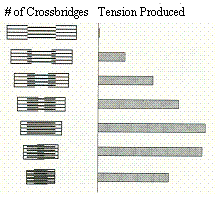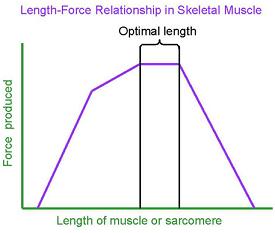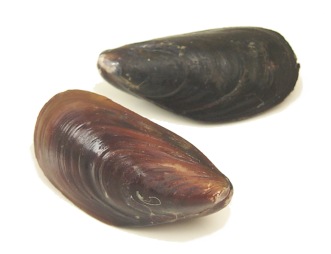Trade-Offs: Force and Power

 As previously stated, the force produced by a
muscle depends on the number of cross bridges present. This means that force depends on the cross sectional area
of a muscle.
As previously stated, the force produced by a
muscle depends on the number of cross bridges present. This means that force depends on the cross sectional area
of a muscle.
F~L2
The picture to the left shows the number of cross bridges and tension
produced as the muscle sarcomeres contract.
This can also be graphed as shown to the right.
This shows that the maximum
tension force occurs in mid-contraction.
*image information at bottom of page
Long sarcomeres can achieve more cross
bridges, and therefore can produce a greater force.
http://biology.kenyon.edu/courses/biol105/html/muscle-lt.jpg
But, they cannot contract as
fast.
 Short sarcomeres have greater velocity, but cannot produce
the same amount of power.
Short sarcomeres have greater velocity, but cannot produce
the same amount of power.
e.g. A Clam has long sarcomeres
to produce a strong
tension to keep it shut. It does not need to be
quick.
e.g. A squid
needs to be extremely quick to shoot out its
tentacles to catch
prey.
http://www.foodsubs.com/Photos/mussels-priceedwardisland.jpg
*image information at bottom of
page
http://www.foodsubs.com/Photos/fish-squid.jpg
This shows the maximum force is
when there is no velocity, and their is a maximum speed at zero force.
However, the maximum power
produced occurs at about one third the muscles maximum velocity.
 *image information at bottom of page
*image information at bottom of page
Power is the work done per second. It is given in the units of watts.
P= Work/Second
*image information: images from
http://mercury.bio.uaf.edu/courses/biol310/Biol%20310%20Class%2012.ppt

 Short sarcomeres have greater velocity, but cannot produce
the same amount of power.
Short sarcomeres have greater velocity, but cannot produce
the same amount of power.